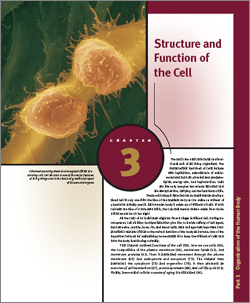
 | The cell is the basic structural and functional unit of all living organisms. The characteristic functions of cells include DNA replication, manufacture of macromolecules such as proteins and phospholipids, energy use, and reproduction. Cells are like very complex but minute factories that are always active, carrying out the functions of life. These microscopic factories are so small that an averagesized cell is only one-fifth the size of the smallest dot you can make on a sheet of paper with a sharp pencil. Each human body ismade up of trillions of cells. If each cell was the size of a standard brick, the colossal human statue made from those bricks would be 10 km high! All the cells of an individual originate from a single fertilized cell. During development, cell division and specialization give rise to a wide variety of cell types, such as nerve, muscle, bone, fat, and blood cells. Each cell type has important characteristics that are critical to the normal function of the body as a whole. One of the important reasons for maintaining homeostasis is to keep the trillions of cells that form the body functioning normally. This chapter outlines functions of the cell (58), how we see cells (60), the composition of the plasma membrane (60), membrane lipids (61), and membrane proteins (61). Then it addresses movement through the plasma membrane (65) and endocytosis and exocytosis (73). The chapter then addresses the cytoplasm (75) and organelles (78). It then presents an overview of cell metabolism (87), protein synthesis (88), and cell life cycle (92). Finally, some major cellular aspects of aging are discussed (96). |